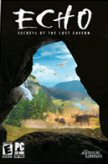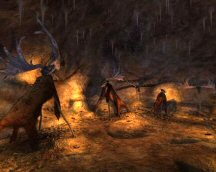In 1940, a group of French teenagers discovered a
hole that had opened in the earth among the roots of a dead tree.
Rocks thrown into the hole sent back deep echoes. One particularly
adventurous young man, Marcel Ravidat, later returned with a
different group of friends to climb down the hole and follow the
echoing sounds. To their astonishment, they came across colorful
paintings of animals that covered the walls of the underground
cavern.
The paintings were ancient – having remained hidden and
undisturbed for seventeen thousand years. The artists who created
them left no trace except the paintings themselves. Who were these
visionaries from the past whose creations danced, leapt and galloped
their way across these ancient walls?
ECHO: Secrets of the Lost Cavern attempts to answer
that question. The story in the game is a classic coming-of-age
quest about a young man not so very different from those teenagers
who, millennia later, followed the echoes and rediscovered the
caverns of Lascaux.
In ECHO, the player takes on the role of Arok, a young Cro-Magnon
hunter from the Upper Paleolithic era. Years earlier, as a child,
Arok had met a stranger who told him about the art of cave
painting. Now the young hunter has stumbled across clues that the
stranger left behind. Arok decides to risk everything in the
ambition to become an artist, and he follows a path through a series
of mysterious caverns in hopes of finding the stranger.
Transported to a Land of Ancient Wonder…
The game begins in a snowy primeval forest, as Arok seeks shelter
during an encounter with a hungry cave lioness.
ECHO is a first person perspective, point-and-click adventure
with 360-degree panning. It takes the player on a journey through
spectacular natural scenery, recreated in photorealistic detail.
You’ll see a misty mountain path, a verdant meadow in the warm light
of mid afternoon, a white water stream, a night encampment under the
haloed moon.
Ambient sounds enrich the worlds. You’ll hear the crackling of a
fire, the howling of the wind (and the wolves), water dripping from
stalactites. Noises echo through the caverns.
The music combines modern and ancient instruments and suits the
historical setting well. Rhythmic percussion predominates, often
using primitive instruments like lithophones and shells to achieve
special effects. Occasionally -- at moments of emotion or triumph
-- you’ll hear strings and the human voice. At those moments the
music evokes an emotion that I would describe as a deeply wistful
yearning.
My only real criticism of the game’s sound is that when I turned
up the volume to hear the music, the voices of the game characters
were much too loud. A chance to adjust music volume separately from
dialog volume would have been appreciated.
… I Made my Way Among Men
Arok encounters a handful of characters as he pursues his quest.
ECHO’s designers have taken great care to present these characters –
their clothing, ornaments, and possessions – with as much historical
accuracy as possible (based on findings of other contemporary
peoples). Each of the characters that Arok meets has a distinct
personality. Each one forces Arok to prove himself. They have
something to teach him, and they move him further along on his
quest. The characters in ECHO are well animated, however they do
tend to remain rooted in one spot, busy with a repetitive activity.
The voice acting for the characters is good – the only exception
being the occasions in which Arok sounds a bit too earnest.
Arok carries a considerable inventory as he travels. You bring
up the inventory by right-clicking with the mouse. The inventory is
easy to use and, for the most part, inventory items are easy to
locate. There’s a magnifying glass that allows you to examine
inventory items – when you do this, the main screen darkens so that
you can see each item more clearly – an example of the game
designers’ attention to detail.
Also on the inventory screen are icons that allow you to access
the in-game documentary data base. At first, only part of the
information from the database is accessible. As you progress
through the game, more information is unlocked – when more is
available, a shell-like icon appears on the game screen. I thought
this was a nice feature, as it rewarded success with further
background detail.
The database occasionally held information that tangentially
helped with a puzzle challenge. But more often it served to give a
sense of the vast swath of time between the primitive world of the
game and the modern world of the gamer.
Gradually, you learn more about Arok’s people from the
perspective of modern scientists – how Cro-Magnon Man survived, how
he created beautiful ornaments, what he might have thought about his
world. This is the most intriguing in-game database/encyclopedia
that I’ve seen (and I’ve seen many). After satisfying your
curiosity about an aspect of Paleolithic culture, with one click
you’re out of the realm of scientific conjecture and back into the
gameworld, swept up in an encounter with a bear, or trying to start
a fire, or staring up at a rock formation, puzzling over the symbols
on its surface.
There is an in-game Objectives Journal (also accessible from the
inventory screen) which records your progress and gives you a bit of
direction in terms of the challenge that Arok is currently facing.
This is a helpful feature if you are the sort of person who will
take several days or weeks to play the game, and therefore might
have trouble recalling exactly what was happening when you last
exited the game. The journal does make solving the puzzles somewhat
easier, so if you want an even greater challenge, don’t consult it
until absolutely necessary. Expert gamers can make their way
through the game without even glancing at the Objectives Journal.
I Ate, Drank and Toiled as One of Them
There are a wide variety of puzzles in ECHO. Some are survival
challenges where you must use the environment (and what you find in
it) creatively. There are pattern observation puzzles (some involve
distinguishing colors), inventory item puzzles, construction
challenges, simple tone matching puzzles, even an anti-timed-puzzle
challenge -- you fail if you move too fast. Hotspots within the
puzzles can be difficult to find, so close observation (sometimes in
unexpected places) is necessary. Some of the puzzles let you mess
about with pigments and art tools, which is a lot of fun. Many of
the puzzles involve the paintings and symbols on cavern walls, and
these transform themselves when solved. I found watching them to be
delightful.
There are variations on traditional puzzles, and some of these I
liked less than the others. There’s a maze that’s actually a
pattern interpretation challenge. There’s a jigsaw puzzle that’s
actually a pixel-hunting challenge. And there’s a slider puzzle
that is a new “take” on sliders. These three particular challenges
definitely arrested my progress in the game for quite awhile. That
tuft of hair you pick up beside the entrance to the main cavern was
torn directly from my head.
Often, in Dreams, I Return
ECHO: Secrets of the Lost Cavern surprised me. I
was surprised at the artistry and ingenuity of “primitive” man. The
characters in Arok’s world experience a knowledge of and connection
to the natural world that has somehow been lost in more modern
times.
At the game’s heart are the wall paintings from caverns like the
one at Lascaux, and once the game is finished these images are hard
to get out of your mind. Their rediscovery in 1940 brought crowds
of sightseers (rightly so – there is much to marvel at). Attempts
to circulate the air and to admit admiring crowds caused the artwork
to degrade so rapidly that now most of these paintings are no longer
available for public view. In ECHO, the gamer works her way through
various challenges in a fascinating primeval environment, arriving
at last to see these treasures fresh and unspoiled.
Quick List for ECHO: Secrets of the Lost Cavern
First person perspective, point-and-click, 360-degree panning.
An entertaining glimpse into prehistory. Startlingly beautiful
natural surroundings, rhythmic, occasionally wistful music.
Interaction with a small cast of characters.
A well constructed in-game database allows you to learn more if
you wish, but the game stands on its own even if you never consult
it. Inventory puzzles, pattern interpretation, construction
challenges. Simple musical tone matching puzzles, a faux maze, a
“Towers of Hanoi” puzzle, one difficult, unusual slider. No puzzles
that require quick reflexes. You can die at one point, but are
quickly returned to the moment before you foolishly stepped in a
particular spot.
ECHO loaded and played without a glitch. There’s a family
friendly main menu – several people can save their own games. Saves
are unlimited and you can save anywhere except in the middle of
animations or self-contained puzzle sequences.
ECHO: Secrets of the Lost Cavern is aimed at gamers
who enjoy a coming-of-age puzzle quest while exploring
extraordinary, detailed, primeval environments.
Final Grade: A-
design copyright ©
2005
GameBoomers
Group

